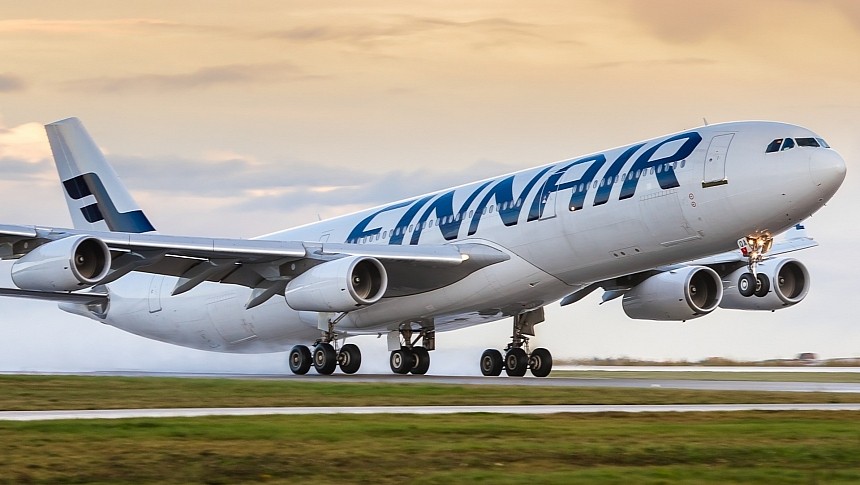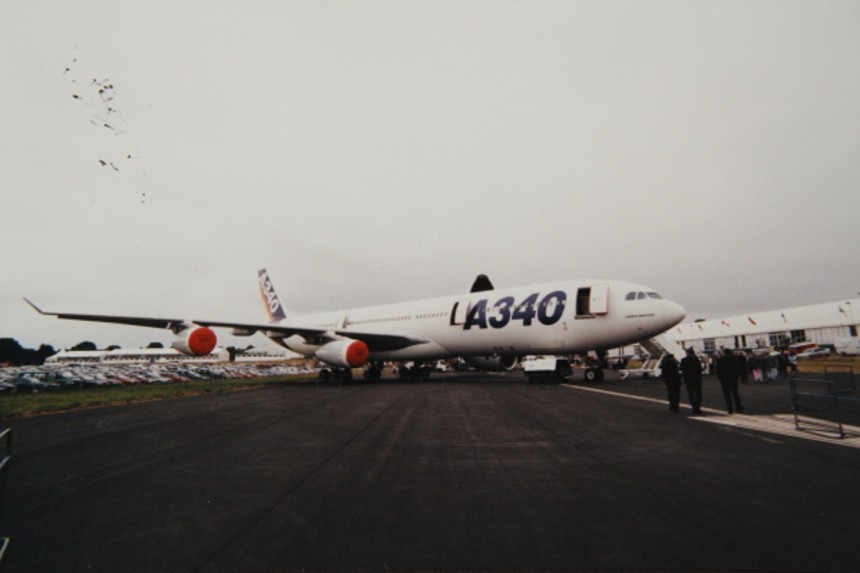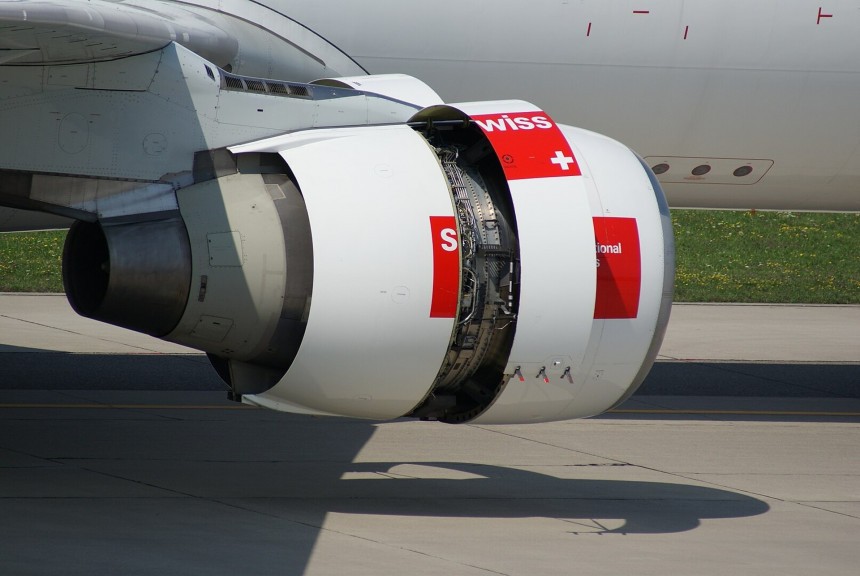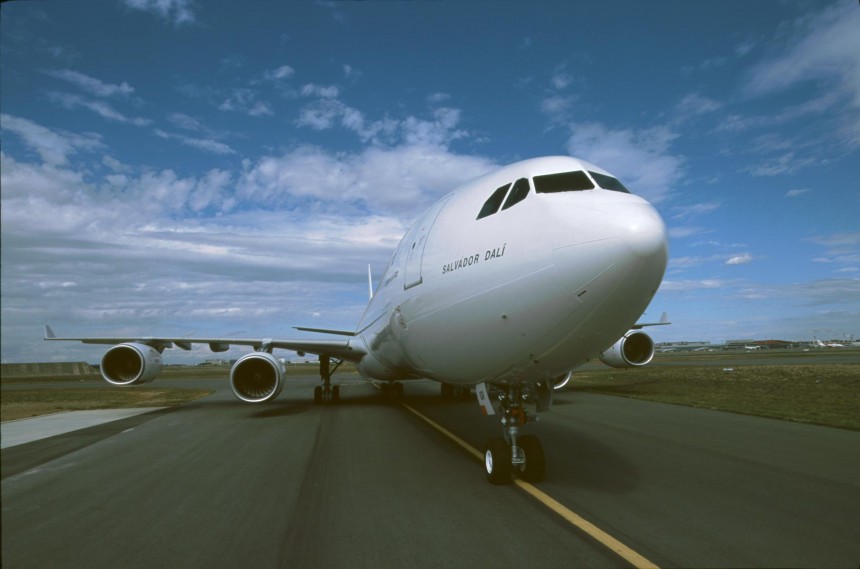A short while ago, we told the story of the Boeing 757, pound-for-pound the most overpowered twin-jet passenger airliner of the jet age of aviation. It was and still is the kind of jet that can legitimately impress fighter jets with its climb-to-altitude capabilities thanks to two colossal engines. If all that's true, think of the Airbus A340 as the complete opposite. Despite sporting four engines instead of two, the A340 is notorious worldwide for being an absolute pig. For better or worse, the A340 is like a Geo Metro in the sky.
The story of the A340 is one rooted in the larger history of Airbus itself. One rooted in the idea that a consortium of European aerospace contractors could one day join forces and bring the fight to the established American aristocracy in the civil airliner space. The agreement between members of the British, West German, and French aerospace sectors to found a novel multi-national civil airliner manufacturer was first proposed all national parties met at the 1965 Paris Air Show. The deal was formally ratified in 1967.
The firm's first commercial product, the A300 wide-body twin-jet, laid the foundation for what would become one of Europe's most important manufacturing hubs. The A300 first flew a mere five years after the agreement of 1967 and entered service with Air France in 1974. But even before the A300's first flight with paying passengers, Airbus personnel envisioned a day when a whole fleet of aircraft under their name would bring the fight to Boeing and McDonnell Douglas across the spectrum of civil airliners from the smallest puddle jumpers to the biggest, most outrageous jumbo jets.
Before the minutia of Airbus' grand scheme for market dominance was finalized, plans called for a fleet of airliners rooted in the original A300 platform, which could be extensively modified to host a slew of niches and specialized operating environments running from twin-jets to quad-jets and both narrow and wide-body aircraft. As many as nine different A300 offshoots were proposed in the early-to-mid 1970s, labeled the A300B1 up to the B9.
Similar to practices done in the automotive space, as with Chrysler's K platform in the 1980s, on which dozens of vehicles shared a common platform to save on development costs, Airbus aimed to expedite the often-grueling airliner design process by making its entire fleet share a common platform. The first of these A300 offshoot designs to see production was the A310, marketed as a competitor to Boeing's iconic 767 and essentially an A300's airframe with the fuselage shortened by roughly 6.95 m (22.8 ft).
In turn, Airbus' current bread and butter aircraft, the narrow-body, twin-jet A320 family, complete with new-fangled, fly-by-wire controls, entered service with Air France in 1988 after a lengthy development period under the project name SA (Single Aisle). The new jet competed against two American titans, the Boeing 737 and the McDonnell Douglas DC-9, and did so with grace and distinction. Right off the bat, Airbus had a winning combination in the A300, A310, and A320. The fearsome tag team helped Airbus proliferate its business globally from the mid-80s to the early 1990s.
It was the first time a European aerospace manufacturer had come close to challenging American hegemony in the airliner space since the de Havilland Comet beat the Boeing 707 and Douglas DC-8 to commercial service in the 1950s. But Airbus wasn't done innovating yet, as more gaps in the civil airliner market were rife for the taking to whoever wanted to capitalize. As early as 1973, another addition to the nine A300 family aircraft already proposed was conceptualized and aimed at the big fish in the airliner pond. However, it was how to go about designing this new airframe that made the situation particularly tense for some within Airbus.
A handful within the company, particularly on the German side of the operation, called for an A300-derived, wide-body airframe with two engines and explicitly targeted at the North American market. All the while, others within Airbus aiming to capitalize on gaps in airline coverage in East Asia favored a quad-engine, wide-body airframe marketed as an alternative to the larger Boeing 747, McDonnell Douglas DC-10, and, for a time, the Lockheed L-1011 TriStar.
For a time in the early 1980s, Airbus was in talks with McDonnell Douglas themselves to jointly manufacture an airplane to the combined specifications of Airbus's twin and quad jet proposal. But these efforts stalled when Airbus refused to cooperate with McDonnell Douglas's wishes to keep the tri-jet architecture native to their DC-10. In time, Airbus's two factions advocating for either a twin or quad-jet arrangement for its new airframe conceded four engines were more marketable internationally than two. The only question remaining was what on Earth would power the new jet. Therein lay the future A340's true weakness, its engines.
The engine in question was the Franco-American CFM International CFM56 high-bypass turbofan engine. With well north of 30,000 examples produced since 1974, the CFM56 is one of the most prolific engines of the jet age. Everything from the DC-8 to multiple Boeing 737 iterations and all of the associated military variants therein have made use of the CFM 56 over the last 50 years. In itself, there was nothing wrong at all with the CFM 56. In some configurations, the engine jetted as much as 27,300 lbs (121 kN) of thrust when fitted to the Boeing 737-800 and 737-900. But all these applications had one common binding thread; they were all narrow-body, twin-jet aircraft.
When applied to a large, quad-engined airliner like the early A340-200s and A340-300s that first flew in October 1991, such narrow-body-optimized engines as the CFM 56 turned out less-than-stellar results. Though its engines burned relatively little fuel compared to similarly-sized jets from Boeing, performance metrics like takeoff distances and climb time to altitude figures all sorely lagged behind the A340's competitors from the moment it entered service with Lufthansa in March 1993. On long-haul flights, early A340s flew considerably farther away from supersonic than its rivals, equaling longer flights with increased stress on flight crews as a result.
Considering all four engines have at least 275 metric tons (303.1 US tons) to carry aboard a fully loaded A340-200 and even more for the stretched A340-300, is it any surprise that early examples routinely performed equal-to or worse than the equivalent Boeing offering, the twin-jet 777, even with two more engines? Compared to the narrow-body 757, the jet routinely pegged as the most overpowered airliner of the modern era, the early A340s were equally underwhelming to the point of nearly being unnoticeable. So then, it makes all the sense in the world why Airbus went back to the drawing board for the later A340-500 and 600 in the early 2000s.
With the benefit of new British Rolls-Royce Trent 500 turbofans designed from the get-go to operate on wide-body jets, this new breed of A340 set its sights on replacing older DC-10s and 747s in service with airlines across the globe. With as much as 61,900 lbs (275 kN) of thrust to work with per engine, the longer, heavier airframes of these novel Airbus jets were able to bridge some of the gaps in performance that plagued the platform since its inception. In its ultimate form, the A340-600HGW (High Gross Weight), the aircraft can operate fully loaded at 380 tonnes (840,000 lbs) across a ferry range of 14,630 km (7,900 nmi; 9,090 mi).
The last of the 377 A340s delivered to airline customers was completed in 2012. With the completion of Airbus' A380 jumbo jet program in 2021, it's doubtful whether Airbus will ever again field another wide-body, quad-jet airliner again. With the industry shifting ever more towards more efficient twin-jets, the A340 will forever remain a curious footnote in aviation history. One which yielded surprising insights into the finer details of civil aviation than people might give it credit for. It'd be wrong to say the A430 is a bad plane per se, it's yet to see a fatal accident in three decades of commercial service. But time is money and money's on the line, an extra hour in the air means everything to the folks who might be aboard.
The firm's first commercial product, the A300 wide-body twin-jet, laid the foundation for what would become one of Europe's most important manufacturing hubs. The A300 first flew a mere five years after the agreement of 1967 and entered service with Air France in 1974. But even before the A300's first flight with paying passengers, Airbus personnel envisioned a day when a whole fleet of aircraft under their name would bring the fight to Boeing and McDonnell Douglas across the spectrum of civil airliners from the smallest puddle jumpers to the biggest, most outrageous jumbo jets.
Before the minutia of Airbus' grand scheme for market dominance was finalized, plans called for a fleet of airliners rooted in the original A300 platform, which could be extensively modified to host a slew of niches and specialized operating environments running from twin-jets to quad-jets and both narrow and wide-body aircraft. As many as nine different A300 offshoots were proposed in the early-to-mid 1970s, labeled the A300B1 up to the B9.
Similar to practices done in the automotive space, as with Chrysler's K platform in the 1980s, on which dozens of vehicles shared a common platform to save on development costs, Airbus aimed to expedite the often-grueling airliner design process by making its entire fleet share a common platform. The first of these A300 offshoot designs to see production was the A310, marketed as a competitor to Boeing's iconic 767 and essentially an A300's airframe with the fuselage shortened by roughly 6.95 m (22.8 ft).
In turn, Airbus' current bread and butter aircraft, the narrow-body, twin-jet A320 family, complete with new-fangled, fly-by-wire controls, entered service with Air France in 1988 after a lengthy development period under the project name SA (Single Aisle). The new jet competed against two American titans, the Boeing 737 and the McDonnell Douglas DC-9, and did so with grace and distinction. Right off the bat, Airbus had a winning combination in the A300, A310, and A320. The fearsome tag team helped Airbus proliferate its business globally from the mid-80s to the early 1990s.
It was the first time a European aerospace manufacturer had come close to challenging American hegemony in the airliner space since the de Havilland Comet beat the Boeing 707 and Douglas DC-8 to commercial service in the 1950s. But Airbus wasn't done innovating yet, as more gaps in the civil airliner market were rife for the taking to whoever wanted to capitalize. As early as 1973, another addition to the nine A300 family aircraft already proposed was conceptualized and aimed at the big fish in the airliner pond. However, it was how to go about designing this new airframe that made the situation particularly tense for some within Airbus.
A handful within the company, particularly on the German side of the operation, called for an A300-derived, wide-body airframe with two engines and explicitly targeted at the North American market. All the while, others within Airbus aiming to capitalize on gaps in airline coverage in East Asia favored a quad-engine, wide-body airframe marketed as an alternative to the larger Boeing 747, McDonnell Douglas DC-10, and, for a time, the Lockheed L-1011 TriStar.
For a time in the early 1980s, Airbus was in talks with McDonnell Douglas themselves to jointly manufacture an airplane to the combined specifications of Airbus's twin and quad jet proposal. But these efforts stalled when Airbus refused to cooperate with McDonnell Douglas's wishes to keep the tri-jet architecture native to their DC-10. In time, Airbus's two factions advocating for either a twin or quad-jet arrangement for its new airframe conceded four engines were more marketable internationally than two. The only question remaining was what on Earth would power the new jet. Therein lay the future A340's true weakness, its engines.
The engine in question was the Franco-American CFM International CFM56 high-bypass turbofan engine. With well north of 30,000 examples produced since 1974, the CFM56 is one of the most prolific engines of the jet age. Everything from the DC-8 to multiple Boeing 737 iterations and all of the associated military variants therein have made use of the CFM 56 over the last 50 years. In itself, there was nothing wrong at all with the CFM 56. In some configurations, the engine jetted as much as 27,300 lbs (121 kN) of thrust when fitted to the Boeing 737-800 and 737-900. But all these applications had one common binding thread; they were all narrow-body, twin-jet aircraft.
When applied to a large, quad-engined airliner like the early A340-200s and A340-300s that first flew in October 1991, such narrow-body-optimized engines as the CFM 56 turned out less-than-stellar results. Though its engines burned relatively little fuel compared to similarly-sized jets from Boeing, performance metrics like takeoff distances and climb time to altitude figures all sorely lagged behind the A340's competitors from the moment it entered service with Lufthansa in March 1993. On long-haul flights, early A340s flew considerably farther away from supersonic than its rivals, equaling longer flights with increased stress on flight crews as a result.
Considering all four engines have at least 275 metric tons (303.1 US tons) to carry aboard a fully loaded A340-200 and even more for the stretched A340-300, is it any surprise that early examples routinely performed equal-to or worse than the equivalent Boeing offering, the twin-jet 777, even with two more engines? Compared to the narrow-body 757, the jet routinely pegged as the most overpowered airliner of the modern era, the early A340s were equally underwhelming to the point of nearly being unnoticeable. So then, it makes all the sense in the world why Airbus went back to the drawing board for the later A340-500 and 600 in the early 2000s.
With the benefit of new British Rolls-Royce Trent 500 turbofans designed from the get-go to operate on wide-body jets, this new breed of A340 set its sights on replacing older DC-10s and 747s in service with airlines across the globe. With as much as 61,900 lbs (275 kN) of thrust to work with per engine, the longer, heavier airframes of these novel Airbus jets were able to bridge some of the gaps in performance that plagued the platform since its inception. In its ultimate form, the A340-600HGW (High Gross Weight), the aircraft can operate fully loaded at 380 tonnes (840,000 lbs) across a ferry range of 14,630 km (7,900 nmi; 9,090 mi).
The last of the 377 A340s delivered to airline customers was completed in 2012. With the completion of Airbus' A380 jumbo jet program in 2021, it's doubtful whether Airbus will ever again field another wide-body, quad-jet airliner again. With the industry shifting ever more towards more efficient twin-jets, the A340 will forever remain a curious footnote in aviation history. One which yielded surprising insights into the finer details of civil aviation than people might give it credit for. It'd be wrong to say the A430 is a bad plane per se, it's yet to see a fatal accident in three decades of commercial service. But time is money and money's on the line, an extra hour in the air means everything to the folks who might be aboard.











